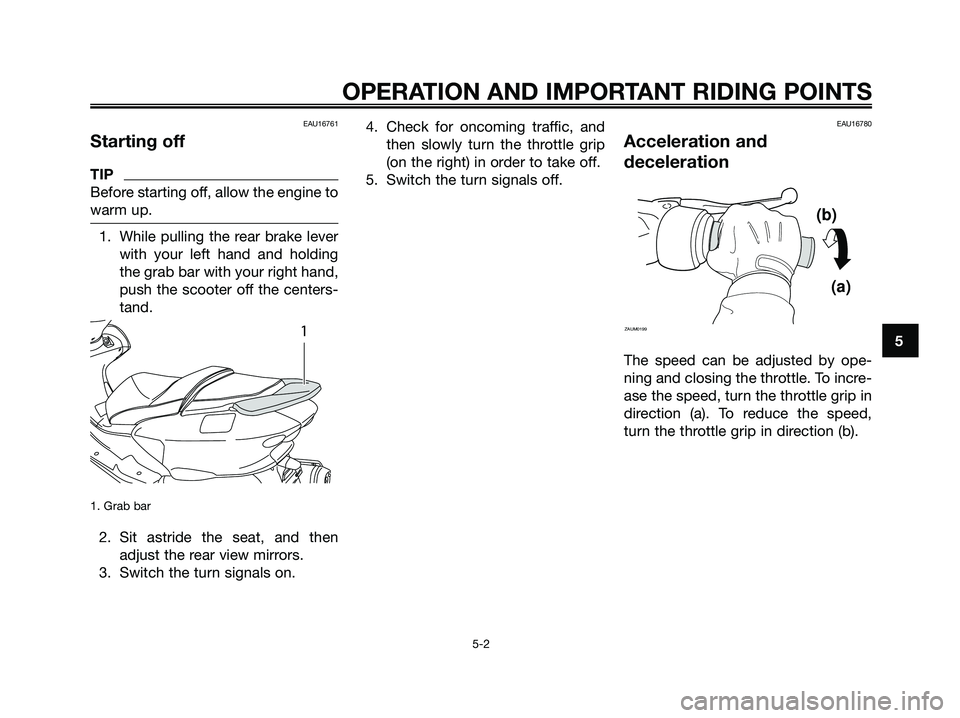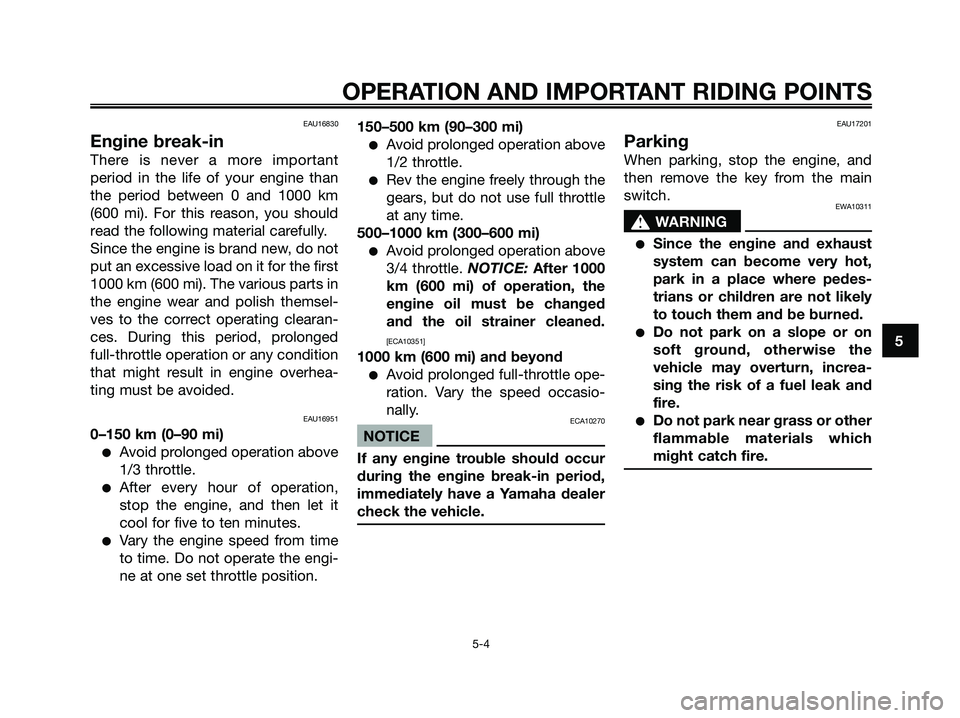2009 YAMAHA MAJESTY 125 engine
[x] Cancel search: enginePage 34 of 84

EAU15951
Read the Owner’s Manual carefully to
become familiar with all controls. If
there is a control or function you do
not understand, ask your Yamaha
dealer.
EWA10271
s s
WARNING
Failure to familiarize yourself with
the controls can lead to loss of
control, which could cause an acci-
dent or injury.
EAUM2171
Starting the engineECA10250
NOTICE
See page 5-4 for engine break-in
instructions prior to operating the
vehicle for the first time.
In order for the ignition circuit cut-off
system to enable starting, the sides-
tand must be up.
See page 3-14 for more information.
1. Turn the key to “ ”.
2. Close the throttle completely.
3. Start the engine by pushing the
start switch while applying the
front or rear brake. NOTICE: For
maximum engine life, never
accelerate hard when the engi-
ne is cold!
[ECA11041]
If the engine does not start, release
the start switch, wait a few seconds,
and then try again. Each starting
attempt should be as short as possi-
ble to preserve the battery. Do not
crank the engine more than 10
seconds on any one attempt. If the
engine does not start, try with the
throttle open 1/8 turn.
1. Rear brake lever
2. Start switch
3. Front brake lever
123
ZAUM0649
OPERATION AND IMPORTANT RIDING POINTS
5-1
5
5D8-F8199-E1.QXD 10/7/08 07:39 Página 34
Page 35 of 84

EAU16761
Starting off
TIP
Before starting off, allow the engine to
warm up.
1. While pulling the rear brake lever
with your left hand and holding
the grab bar with your right hand,
push the scooter off the centers-
tand.
1. Grab bar
2. Sit astride the seat, and then
adjust the rear view mirrors.
3. Switch the turn signals on.4. Check for oncoming traffic, and
then slowly turn the throttle grip
(on the right) in order to take off.
5. Switch the turn signals off.
EAU16780
Acceleration and
deceleration
The speed can be adjusted by ope-
ning and closing the throttle. To incre-
ase the speed, turn the throttle grip in
direction (a). To reduce the speed,
turn the throttle grip in direction (b).
(b)
(a)
ZAUM01991
OPERATION AND IMPORTANT RIDING POINTS
5-2
5
5D8-F8199-E1.QXD 10/7/08 07:39 Página 35
Page 36 of 84

EAU16793
BrakingEWA10300
s s
WARNING
●Avoid braking hard or suddenly
(especially when leaning over
to one side), otherwise the sco-
oter may skid or overturn.
●Railroad crossings, streetcar
rails, iron plates on road cons-
truction sites, and manhole
covers become extremely slip-
pery when wet. Therefore, slow
down when approaching such
areas and cross them with cau-
tion.
●Keep in mind that braking on a
wet road is much more difficult.
●Ride slowly down a hill, as bra-
king downhill can be very diffi-
cult.
1. Close the throttle completely.
2. Apply both front and rear brakes
simultaneously while gradually
increasing the pressure.Front
Rear
EAU16820
Tips for reducing fuel
consumption
Fuel consumption depends largely on
your riding style. Consider the follo-
wing tips to reduce fuel consumption:
●Avoid high engine speeds during
acceleration.
●Avoid high engine speeds with no
load on the engine.
●Turn the engine off instead of let-
ting it idle for an extended length
of time (e.g., in traffic jams, at
traffic lights or at railroad cros-
sings).
OPERATION AND IMPORTANT RIDING POINTS
5-3
5
5D8-F8199-E1.QXD 10/7/08 07:39 Página 36
Page 37 of 84

EAU16830
Engine break-in
There is never a more important
period in the life of your engine than
the period between 0 and 1000 km
(600 mi). For this reason, you should
read the following material carefully.
Since the engine is brand new, do not
put an excessive load on it for the first
1000 km (600 mi). The various parts in
the engine wear and polish themsel-
ves to the correct operating clearan-
ces. During this period, prolonged
full-throttle operation or any condition
that might result in engine overhea-
ting must be avoided.
EAU16951
0–150 km (0–90 mi)
●Avoid prolonged operation above
1/3 throttle.
●After every hour of operation,
stop the engine, and then let it
cool for five to ten minutes.
●Vary the engine speed from time
to time. Do not operate the engi-
ne at one set throttle position.150–500 km (90–300 mi)
●Avoid prolonged operation above
1/2 throttle.
●Rev the engine freely through the
gears, but do not use full throttle
at any time.
500–1000 km (300–600 mi)
●Avoid prolonged operation above
3/4 throttle. NOTICE: After 1000
km (600 mi) of operation, the
engine oil must be changed
and the oil strainer cleaned.
[ECA10351]
1000 km (600 mi) and beyond
●Avoid prolonged full-throttle ope-
ration. Vary the speed occasio-
nally.
ECA10270
NOTICE
If any engine trouble should occur
during the engine break-in period,
immediately have a Yamaha dealer
check the vehicle.
EAU17201
Parking
When parking, stop the engine, and
then remove the key from the main
switch.
EWA10311
s s
WARNING
●Since the engine and exhaust
system can become very hot,
park in a place where pedes-
trians or children are not likely
to touch them and be burned.
●Do not park on a slope or on
soft ground, otherwise the
vehicle may overturn, increa-
sing the risk of a fuel leak and
fire.
●Do not park near grass or other
flammable materials which
might catch fire.
OPERATION AND IMPORTANT RIDING POINTS
5-4
5
5D8-F8199-E1.QXD 10/7/08 07:39 Página 37
Page 38 of 84

EAU17281
Periodic inspection, adjustment, and
lubrication will keep your vehicle in
the safest and most efficient condi-
tion possible. Safety is an obligation
of the vehicle owner/operator. The
most important points of vehicle ins-
pection, adjustment, and lubrication
are explained on the following pages.
The intervals given in the periodic
maintenance and lubrication chart
should be simply considered as a
general guide under normal riding
conditions. However, depending on
the weather, terrain, geographical
location, and individual use, the main-
tenance intervals may need to be
shortened.
EWA10321
s s
WARNING
Failure to properly maintain the
vehicle or performing maintenance
activities incorrectly may increase
your risk of injury or death during
service or while using the vehicle. If
you are not familiar with vehicle
service, have a Yamaha dealer per-
form service.
EWA15121
s s
WARNING
Turn off the engine when perfor-
ming maintenance unless otherwi-
se specified.
●A running engine has moving
parts that can catch on body
parts or clothing and electrical
parts that can cause shocks or
fires.
●Running the engine while servi-
cing can lead to eye injury,
burns, fire, or carbon monoxide
poisoning – possibly leading to
death. See page 1-1 for more
information about carbon
monoxide.
EWA10330
s s
WARNING
This scooter is designed for use on
paved roads only. If this scooter is
operated in abnormally dusty,
muddy or wet conditions, the air fil-
ter element should be cleaned or
replaced more frequently, otherwi-
se rapid engine wear may result.
Consult a Yamaha dealer for proper
maintenance intervals.
EAU17451
Owner’s tool kit
1. Owner’s tool kit
The owner’s tool kit is located inside
the storage compartment. (See page
3-12).
The service information included in
this manual and the tools provided in
the owner’s tool kit are intended to
assist you in the performance of pre-
ventive maintenance and minor
repairs. However, additional tools
such as a torque wrench may be
necessary to perform certain mainte-
nance work correctly.
1
PERIODIC MAINTENANCE AND ADJUSTMENT
6-1
6
5D8-F8199-E1.QXD 10/7/08 07:39 Página 38
Page 42 of 84

PERIODIC MAINTENANCE AND ADJUSTMENT
6-5
6
ODOMETER READING
CHECK OR ANNUAL
NO. ITEM MAINTENANCE JOB
1000 km 6000 km 12000 km 18000 km 24000 kmCHECK
(600 mi) (3500 mi) (7000 mi) (10500 mi) (14000 mi)
Shock absorber• Check operation and shock
√√√ √
18 *
assembliesabsorbers for oil leakage.
19 *Carburetor• Adjust engine idling speed.√√ √√ √ √
• Change. (See page 3-2). √When the oil change indicator light
20Engine oilcomes on [every 3000 km (1800 mi)]
• Check oil level and vehicle for
oil leakage.Every 3000 km (1800 mi)√
21 *Engine oil
strainer• Clean.√
• Check coolant level and vehicle
√√√ √√
22 *Cooling systemfor coolant leakage.
• Change. Every 3 years
Final transmission• Check vehicle for oil leakage.√√ √23
oil
• Change.√√ √
24 *V-belt• Replace. Every 10000 km (6000 mi)
Front and rear
25*
brake switches• Check operation.√√ √√ √ √
26Moving parts
• Lubricate.√√√ √√
and cables
• Check operation and free play.
Throttle grip • Adjust the throttle cable free play
27 *housingif necessary.√√√ √√
and cable• Lubricate the throttle grip
housing and cable.
5D8-F8199-E1.QXD 10/7/08 07:39 Página 42
Page 45 of 84

EAU19603
Checking the spark plug
The spark plug is an important engine
component, which is easy to check.
Since heat and deposits will cause
any spark plug to slowly erode, the
spark plug should be removed and
checked in accordance with the
periodic maintenance and lubrication
chart. In addition, the condition of the
spark plug can reveal the condition of
the engine.
To remove the spark plug
1. Remove the spark plug cap.
1. Spark plug cap
2. Remove the spark plug as
shown, with the spark plug
wrench included in the owner’s
tool kit.
1. Spark plug wrench
To check the spark plug
1. Check that the porcelain insula-
tor around the center electrode of
the spark plug is a medium-to-
light tan (the ideal color when the
vehicle is ridden normally).
TIP
If the spark plug shows a distinctly
different color, the engine could be
operating improperly. Do not attempt
to diagnose such problems yourself.
Instead, have a Yamaha dealer check
the vehicle.
2. Check the spark plug for electro-
de erosion and excessive carbon
or other deposits, and replace it if
necessary.
To install the spark plug
1. Measure the spark plug gap with
a wire thickness gauge and, if
necessary, adjust the gap to spe-
cification.
Specified spark plug:
NGK/ CR8E1
1
PERIODIC MAINTENANCE AND ADJUSTMENT
6-8
6
5D8-F8199-E1.QXD 10/7/08 07:39 Página 45
Page 46 of 84

1. Spark plug gap
2. Clean the surface of the spark
plug gasket and its mating surfa-
ce, and then wipe off any grime
from the spark plug threads.
3. Install the spark plug with the
spark plug wrench, and then
tighten it to the specified torque.
TIP
If a torque wrench is not available
when installing a spark plug, a good
estimate of the correct torque is1/4–1/2 turn past finger tight. Howe-
ver, the spark plug should be tighte-
ned to the specified torque as soon
as possible.
4. Install the spark plug cap.
EAUM1261
Engine oil
The engine oil level should be chec-
ked before each ride. In addition, the
oil must be changed at the intervals
specified in the periodic maintenance
and lubrication chart and when the oil
change indicator display comes on.
To check the engine oil level
1. Place the scooter on the centers-
tand. A slight tilt to the side can
result in a false reading.
2. Start the engine, warm it up for
several minutes, and then turn it
off.
3. Wait a few minutes until the oil
settles, remove the oil filler cap,
wipe the dipstick clean, insert it
back into the oil filler hole (wit-
hout screwing it in), and then
remove it again to check the oil
level.
Tightening torque:
Spark plug:
20 Nm (2.0 m•kgf, 14.5 ft•lbf)
Spark plug gap:
0.7–0.8 mm (0.028–0.031 in)
1
ZAUM0037
PERIODIC MAINTENANCE AND ADJUSTMENT
6-9
6
5D8-F8199-E1.QXD 10/7/08 07:39 Página 46